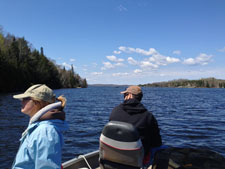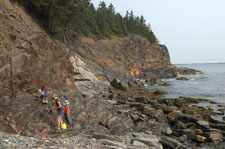Canada's top 10 weather stories for 2014: chapter 5
5. Summer - Hot on the Coasts, Cool in the Centre
After enduring one of the harshest winters in recent memory, Canadians figured Mother Nature owed them a break. A sunny, warm summer was top of mind. For some, their prayers were answered. For others, it was yet another seasonal letdown. Actually, the summer was 1.0°C above average making it the sixth warmest since nationwide record-keeping began in 1948. Much of Canada registered warmer than normal temperatures, with five regions (incl. Atlantic Canada, Northern Prairies, BC southern interior, Western NWT, and Pacific Coast) experiencing their top ten warmest on record. The exception was Southern portions of Ontario and Quebec where, ironically, a large percentage of Canadians live. But even there temperatures were only 0.2°C below seasonal values. For a scarce few, a summer without heat, haze and humidity was perfectly fine. The rest called it a “bummer of a summer” because it just never warmed up.

The Pacific coast featured its third warmest summer in 67 years and the warmest in 10 years at 1.4°C above normal. Besides being spectacularly warm, it was remarkably dry − the seventh driest - with total rainfall 26 per cent below normal and drier than any previous summer that was warmer. The combination of heat and dry made it arguably the most delightful summer on record. Further, coastal British Columbia didn’t get the usual June gloom. Other parts of the province, including the southern mountains and the interior, were similarly warm and dry. In mid-July, interior locations experienced several days above 40°C. The hot spot was Ashcroft at 41.3°C. At the first sign of sunshine in the Lower Mainland and on Vancouver Island, droves of beachgoers raced to the water’s edge. On the other hand, the province faced an extensive and expensive wildfire-fighting season. And on Vancouver Island and the Gulf Islands, level 3 drought conditions prompted officials to ask residents to cut water consumption to limit the drawdown on streams and groundwater. But while west coast lawns were brown and garden beds parched, few were complaining. The only other downside to the glorious weather was the need for health officials in Vancouver to warn residents about strenuous outdoor activities when high amounts of ground-level pollutants prevailed.
The west coast summer spilled over into Alberta where July and August featured temperatures almost 2°C warmer than normal and precipitation at about 56 per cent of usual. In July, Calgary had the third warmest month of any month in 72 years. Under unusually high humidity, health authorities issued heat advisories and energy officials pleaded with Albertans to ease off on power consumption.

Atlantic Canada was just as warm as the west coast − 1.5°C above normal for the fourth warmest summer on record. In St. John’s, July was the hottest month on record; no month going back 140 years has ever been warmer at 19.7°C or 3.9°C above normal. In total, all but two July days were warmer than normal. Incredibly, St. John’s was almost as warm as Toronto and trumped it on its number of hot days with 19 above 25°C. Toronto, Ottawa and Montreal had fewer days above 25°C than St. John’s! Warm, dry conditions left rivers across Newfoundland and Labrador with low water levels and “boiling” temperatures prompting the Department of Fisheries and Oceans to close 63 salmon rivers across the province. But while conditions were dry, the air was not. On July 30, the humidex in St. John’s hit a new all-time record when it topped out at 38.7. During July, the high demand for fans and backyard pools stripped store shelves bare of these items, leaving consumers high and dry - and very hot.

Residents in the central part of the country - including western Quebec, Ontario, Manitoba and parts of Saskatchewan - felt left out in the cold. Days with maximum temperatures above 30°C generally numbered two to four at most. And the lack of sunshine gave the impression of much cooler temperatures. Hamilton saw only one day over 30°C all year and that was on June 17 at 30.3°C. In 2013, there were 9 hot days and 25 the year before. Similarly, London counted only one hot day - June 16 - and that was almost a week before the official start of summer. For Windsor, which typically leads the East with the warmest summers, it was the coldest July in 22 years. In southern Ontario, July and August were the second coldest two months in 55 years of records. Only 1992, often referred to in modern weather circles as “the year without summer,” was worse. Toronto went eight weeks in the warmest part of the year without registering a temperature at or above 30°C. For stations in southwestern Ontario, it was June that was the warmest summer month; a rare occurrence.
Some Ontario and Quebec residents tried to make good of a lousy situation by claiming they were grateful for a no-smog, energy-saving, mosquito-free, tree-loving kind of summer. True, summer was great for those with breathing difficulties. Cooler temperatures meant much less smog and fewer pollutants in the air. Indeed, Ontario featured an unprecedented zero smog days. Gardens and lawns stayed lush and green and nobody had to turn on the sprinkler. Energy-sucking air conditioners were also often silent, resulting in more than 10 per cent savings. But even the most optimistic of residents had to admit that the weather was lousy for vacationers, day trippers and beachgoers who faced conditions more conducive to sweaters than speedos. The water was so cold that even kids stayed away. Case in point - the Great Lakes water temperatures were three to six degrees cooler than last year. By Labour Day, most Canadians in the middle of the country were asking the same thing, “What happened to summer?”